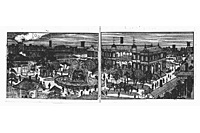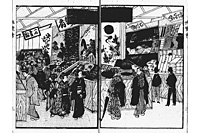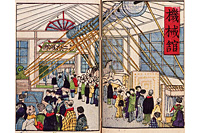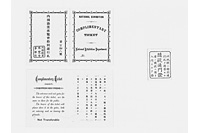Second National Industrial Exhibition
Success in spite of recession
- Period
- : March 1, 1881 - June 30, 1881
- Venue
- : Tokyo Ueno Park
- No. of visitors
- : 823,094
The second National Industrial Exhibition was held at a time when Japan was experiencing inflation triggered by the efforts to raise funds to fight the Seinan Civil War (Satsuma Rebellion), as well as a recession caused by an outflow of specie due to trade imbalances after the opening of Japanese ports to the world at the end of the Edo period. Nevertheless, the number of exhibits displayed at the second exposition increased four-fold from that of the first event. In almost all aspects, such as the number of visitors, the second exposition surpassed the first. While the first was held under the jurisdiction of the Naimu-sho (Ministry of Home Affairs), the second was held under the Okura-sho (Ministry of Finance), in addition to the Naimu-sho, indicating that the entire government was focusing further efforts on this event.
In the approximately 143,000 m2 venue, the main building and six other exhibition structures were constructed. The second National Industrial Exhibition successfully attracted many visitors, partly because it was opened in March in anticipation for drawing many of the cherry-blossom viewers in Ueno. The total number of visitors during the event period was about 820,000, with a daily average of 6,740 visitors, almost double of that of the first exposition. The second exposition was visited by the Meiji Emperor and the Empress, who observed the event attentively.
As he had done at the first National Industrial Exhibition, G. Wagener, a foreigner employed by the Japanese government at that time, played a guidance role at the second National Industrial Exhibition. In his report to the Japanese government, he analyzed the situation of Japanese industries in those days and presented his recommendations for the future. One of his recommendations was that the Japanese agricultural industry should be developed with the introduction of overseas funds and technologies. Such recommendations were made as a form of resistance against the Japanese government, which had abolished the employment of foreigners at the Noshomu-sho (Ministry of Agriculture and Commerce). Thus, a contrast became clear between Wagener's beliefs and the Japanese government's policies of seeking independence from overseas technical experts.
At the first National Industrial Exhibition, items were exhibited according to the exhibitors' prefectures. At the second National Industrial Exhibition, exhibits were displayed in categories, in order to stir a sense of rivalry between the exhibitors. In anticipation of further improvement and development of the exhibits displayed at the first event, the second exposition prohibited the display of items similar to those exhibited at the first event.
- References:
Kuni, Takeyuki.: Hakurankai no jidai: Meiji seihu no hakurankai seisaku (Iwata shoin, 2005) <D7-H68>
Yoshida, Mitsukuni (ed).: Zusetsu bankoku hakurankaishi: 1851-1942 (Shibunkaku shuppan, 1985) <D7-66>





